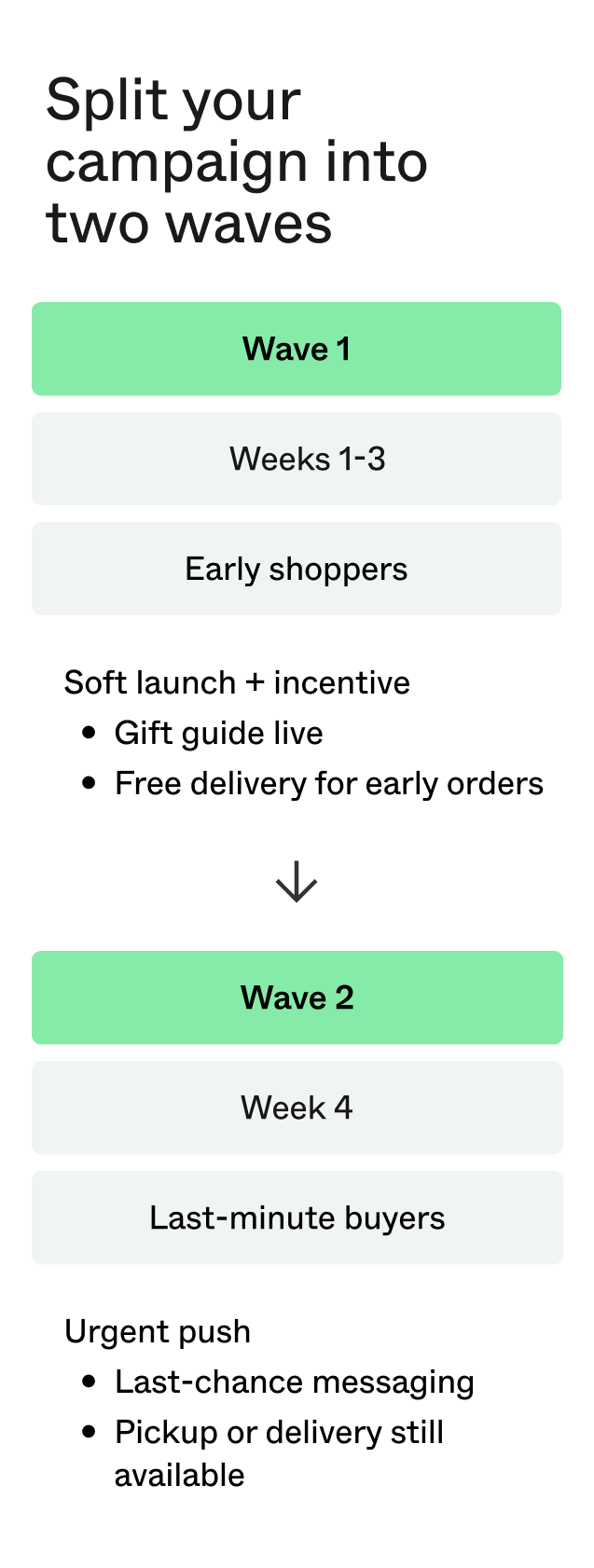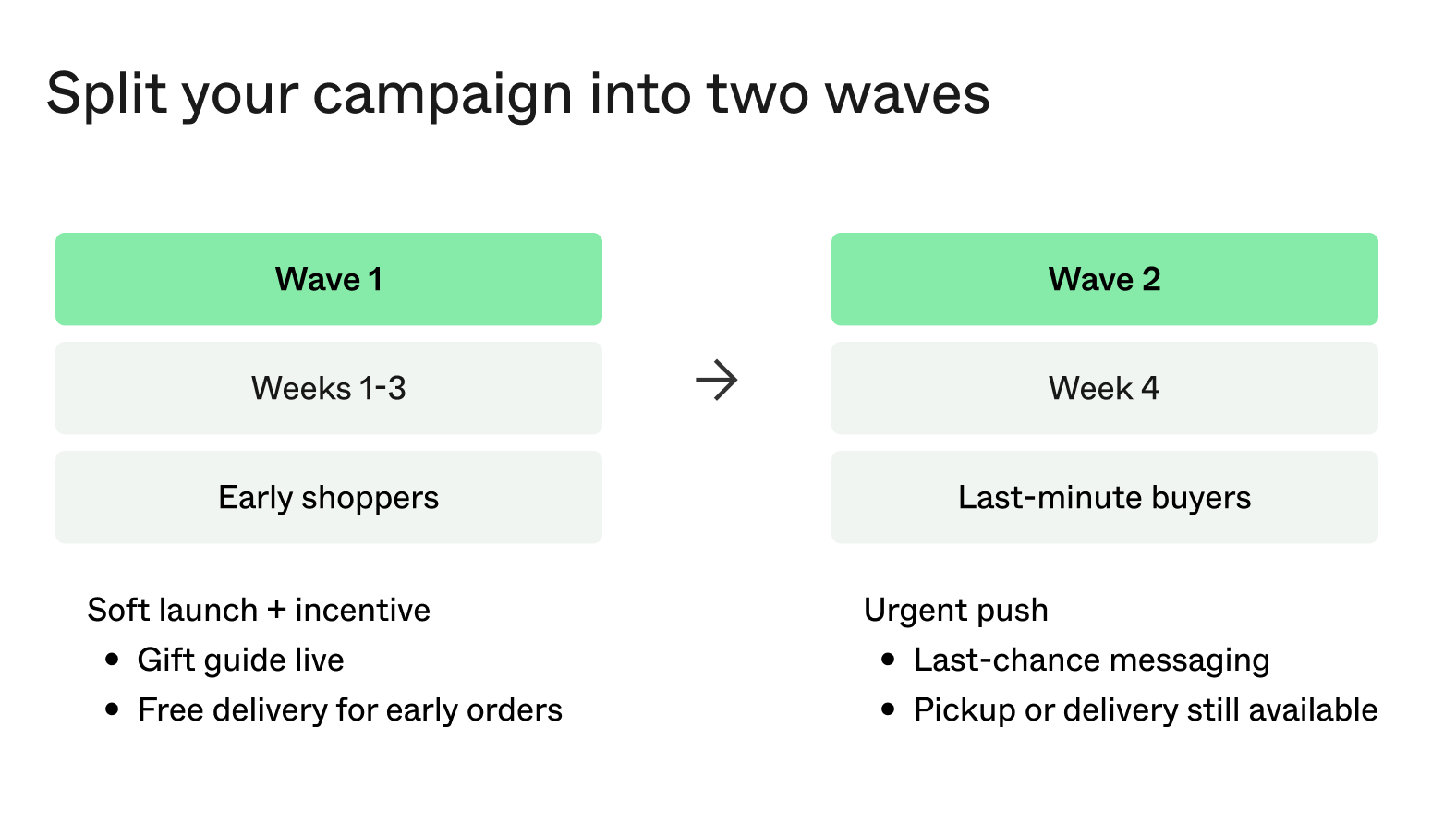At a glance
- With a spike in demand from ready-to-purchase customers, Mother’s Day remains one of the best sales boosters of the year
- A two-phase campaign strategy helps you connect with both early planners and last-minute buyers
- Clear product copy and smart partnerships can expand your reach and help you show up in AI-driven gift searches
Mother’s Day is one of the most important seasonal events on the retail calendar, and it continues to deliver strong results for small businesses. From florists and cafés to gift shops and wellness providers, the lead-up to the day sees a clear rise in customer demand.
Shoppers are actively looking for meaningful gifts, and small businesses are perfectly placed to offer thoughtful, quality-driven options. Interest in Mother’s Day starts to build weeks in advance and peaks in the final days, giving you a well-defined window to capture attention with timely offers and smart promotions.
In this article, we’ll share five key insights and tactics to turn this opportunity into real results.
Reach early planners and last-minute buyers
Many Mother’s Day shoppers buy at the last minute, but a good portion plan ahead. This creates two distinct sales windows for small businesses. Instead of running a single campaign, stronger results come from splitting your efforts into two phases.
How to do it:
- Phase 1: Start early with a soft launch. Share a gift guide, drop a limited-edition product, or offer a small bonus for early purchases. This builds awareness and gives planners a reason to act.
- Phase 2: In the final week, shift your messaging to urgency. Remind customers of order cut-offs, last-minute availability, or local pick-up options. Clear calls to action like “Ready for Sunday” or “Final orders closing soon” help convert undecided buyers.
It’s a flexible Mother’s Day sales strategy that works for both retailers and service providers, especially those balancing online and in-store channels.



Example: One small business that usually sells weekend pottery classes ran a two-part Mother’s Day campaign to fill quieter midweek sessions. The first phase focused on “gifting an experience” and targeted adult children looking for something different to do with their mums.
In the second phase, they pivoted to promoting digital gift cards for last-minute buyers, with a simple message: “No shipping required. Book when you’re ready.” The campaign sold out two weeks of midweek spots, without touching their pricing.
Take the guesswork out of gifting
One of the biggest reasons shoppers delay buying a Mother’s Day gift is simple: they don’t know what to get. With too many choices, unclear pricing, and the pressure to “make it special,” it’s easy to procrastinate, or abandon the purchase entirely. Helping customers feel confident in their decision, especially when they’re short on time, is one of the most effective ways to increase conversions.
How to do it:
- Curate gift ideas into simple, scrollable formats. Think “Top Picks,” “Gifts for New Mums,” or “Something for the One Who Says She Doesn’t Need Anything.”
- Highlight bestsellers or staff picks. A line like “Our most gifted item last year” gives shoppers confidence and reduces indecision.
- Add price filters or categories like “Gifts under $50.” This helps budget-conscious shoppers find options faster and avoid overwhelm.
- Share helpful, sharable content. Use simple visuals and copy that people feel good about forwarding, like gift guides for overthinkers, heartfelt captions, or last-minute prompts.
Example: Digital lifestyle brand The Inarra shared a “Gifts for Mum Under $150” guide ahead of Mother’s Day 2024, featuring a curated mix of beauty, wellness and homeware picks from The Iconic. The layout was clean and scroll-friendly, the products were grouped by vibe rather than category, and the caption called out express shipping for last-minute shoppers.

Make gifting easier with thoughtful add-ons
When customers are short on time or energy, small details can make all the difference. Free gift-wrapping, flexible delivery or fast pickup can turn your Mother’s Day deal into an easy yes for time-poor shoppers. These extras show that your business understands what buyers need and makes the whole gifting experience easier.
How to do it:
- Offer options that remove friction. Instant e-gift vouchers, local pickup and fast delivery all make it easier to buy on the spot.
- Include thoughtful extras. Think gift-wrapping, personal notes or pairing ideas like “Goes perfectly with a bottle of wine or a Sunday sleep-in.”
- Make it clear you’ve simplified gifting. Use phrases like “No wrapping needed” or “Send straight to Mum” to reduce hesitation.
- If you offer services, reduce the admin. Instant vouchers, pre-scheduled appointments or nicely packaged gift cards give buyers more flexibility.
Example: New Zealand skincare brand RAAIE promoted its AM/PM set as a luxurious Mother’s Day gift, pairing premium packaging with practical touches like free shipping and guaranteed delivery before the weekend. Combining elegant presentation with convenience made the offer feel both thoughtful and easy to act on.

Join forces to offer something special
You don’t need to start from scratch to make your Mother’s Day offer feel fresh. A smart partnership with another small business can help you reach new audiences, add variety to your range and give your promotion a creative edge without taking on all the work alone.
How to do it:
- Look for a natural fit. A café might collaborate with a florist. A skincare brand could partner with a ceramicist to offer a bath and candle gift set.
- Create a seasonal bundle or co-branded product and promote it through both businesses’ websites, emails and social channels.
- Share the story behind the partnership. Talk about how it came together, what makes it unique and why it’s a great fit for Mother’s Day.
Example: A neighbourhood plant shop teamed up with a local bookshop to create “Quiet Morning” gift bundles for Mother’s Day. Each set included a potted indoor plant, a handpicked novel by a female author, and a locally made chocolate bar.
The bundles were styled around themes like “the green thumb,” “the early riser,” and “the bookish mum,” with personalised name tags and optional handwritten notes. Promoted in-store and through social posts featuring staff favourites, the offer sold out ahead of the weekend and brought new foot traffic to both businesses.
Make your products easier to find online
More and more shoppers are using AI tools, voice search and online recommendations to find gift ideas, especially when they’re short on time. That means the way you name and describe your products online can make a real difference. A few small changes can help your business appear in search results, answer common queries and capture more last-minute buyers.
How to do it:
- Use clear, descriptive titles and product copy. For example, “Mother’s Day Gift Box – Tea, Candle and Chocolate” is easier to find than something like “The Audrey Set.”
- Include phrases people actually search for. Think “gifts for Mum under $50” or “Mother’s Day gift idea” in your product descriptions and social captions.
- Add a scannable intro at the top of the page. A short summary of what you sell helps both shoppers and AI tools understand your offer quickly.
- Use everyday language. If you’re selling something niche or original, describe it using the words a customer might type or say aloud when searching.
Why it works: Tools like ChatGPT and voice assistants rely on clear, structured content to generate recommendations. If your product pages reflect how people naturally search, you increase your chances of being suggested, even without paid promotion.
You can also explore how other small businesses use generative AI in this article.

Mother’s Day is a high-intent moment. Customers are already looking for something thoughtful to give. Meet them with the right offer at the right time, and even small moves can lead to meaningful results.
Download our Mother’s Day Sales Cheat Sheet
Need extra funding to make the most of Mother’s Day? Apply in 10 minutes with minimal paperwork and you could access up to $150K within hours.





